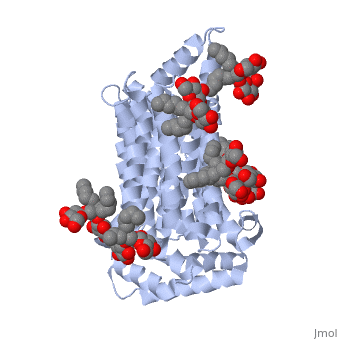Function
The GLUT3 protein, encoded by the SLC2A3 gene in humans, found in mammalian cells, allows for the transport of the glucose molecule across the plasma membrane. It is especially prevalent in the axons of nerve cells in brain tissue. In neurons themselves, GLUT3 is the main glucose transporter that is utilized. In the human body, of the first four glucose transporters discovered (GLUT1, GLUT2, GLUT3, and GLUT4), GLUT3 has a higher glucose affinity and transport capacity, which facilitates its use in glucose transport in neurons. This is significant because the glucose levels surrounding the neuron are five times lower than those found in serum (blood). GLUT3 is also present in sperm, embryos, white blood cells and carcinoma cell lines.
Structure
GLUT3 transport protein is composed of 481 amino acids, , and two different ligands, ligand and ligand . On the protein, one ligand Y01, known as Cholesterol hemisuccinate, is attached to chain a, and one to chain b. Ligand 37X is called Octyl Glucose Neopentyl Glycol, and there are 6 of these ligands on chain a and 3 on chain b.
Disease
Correlations between low levels of glucose transport proteins and abnormal hyperphosphorylation of tau in Alzheimer Disease. Individuals with Alzheimer Disease have decreased levels of GLUT3 and GLUT1 in their brain.

